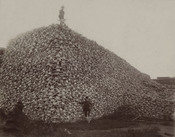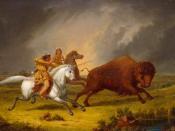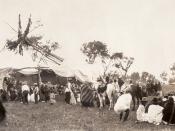The Cheyenne
The Cheyenne Tribe, more commonly known as the Plains Indians, highly evolved through time due to the contributions of the Spaniards to the south and the other Europeans that came from the east. These contributions aided in the thriving of the Cheyenne, as hunting buffalo before the arrival of the horse was "not a productive enough enterprise to support a large population" (Service 114).
This evolution from being an agriculturally based society to being "mounted buffalo hunters" (Service 112) was a key to sustaining the lifestyle and culture of the Cheyenne people. The climate on the Great Plains differed from season to season, with food and resources, such as crops, being plentiful in the spring and early summer months, only to either dry out or freeze during the winter, making those months the toughest to bear for the Cheyenne.
With the land of the Plains being mostly flat, beans and other crops could easily be cultivated, except for the dry climate of the area.
Because of the dry climate, crops such as beans, maize, and squash was "limited to river bottomlands" (Service 114). The tools and machinery required to successfully farm the dry land away from the rivers were not available to the Cheyenne, so hunting became a necessity. The major source of food, clothing, and shelter for these people was the buffalo, which roamed freely about the Plains. However, the Cheyenne also hunted the likes of wild sheep, deer, and antelope through the Plains, ambushing them in small groups (Service 119).
The environment affected the lifestyles of the Cheyenne as much as it did those animals that they hunted. In the summer and warmer months, the tribes would band together into a large group, mainly for large hunting and gathering purposes. This behavior mirrored that...


